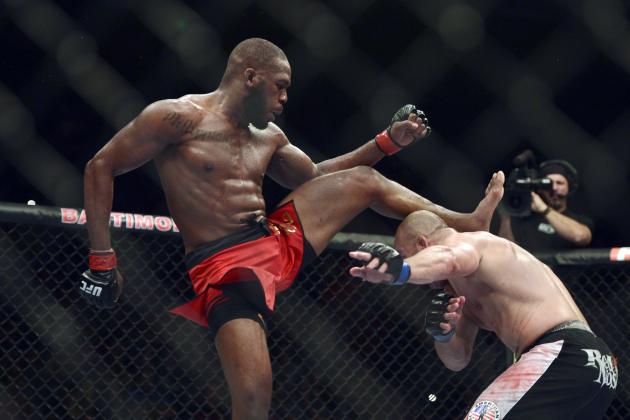For years, it was relatively easy to pinpoint the best fighter in mixed martial arts. Depending on your stylistic or aesthetic biases, it was bound to be one of two men.
Fans of unsurpassed artistry gravitated toward Anderson Silva, the middleweight champion who ruled the 185-pound division with his signature swagger and moments of sheer brilliance. At his best, Silva made the best fighters in his weight class look like children, mere victims to torture and taunt before finally, mercifully, putting them out of their misery.
If your taste ran to the smashmouth, there was Georges St-Pierre, a welterweight legend who used powerful takedowns and a bludgeoning jab to beat all comers for nearly a decade straight. A French Canadian karateka with no formal wrestling pedigree, St-Pierre was somehow able to put even decorated American collegians on their backs with ease, becoming the most dominant grappler in the history of the sport in the process.
They were, with apologies to Fedor Emelianenko and a host of other legends, the two best fighters the sport had ever seen.
No more.
St-Pierre fell victim to lethargy, a battle with UFC over the future of drug testing and, finally, a torn ACL in his left knee. When last we heard from him, he was taking a break from fighting—and it remains unclear if he will ever return to the Octagon.
Silva's dominance ended in a more traditional manner. He was beaten soundly, twice, by successor Chris Weidman, who may turn out to be an improved version of St-Pierre. In their first fight, the 38-year-old Silva's age finally caught up with him. His lightning reflexes, the otherworldly head movement and instincts that once evoked comparisons to superhuman characters in The Matrix abandoned him against Weidman, who made the champion pay for dropping his hands and taunting with a left hook to the chin.
When Silva broke his left leg against Weidman's shin in their rematch, it became clear the king was dead. Though he is training for a return, it's hard to see the aging and fragile former legend resuming his reign.
MMA is ready for a new king. Pinpointing him, however, isn't quite as easy as it seems—and that's pretty exciting. And it's a question that can't be answered on paper using the always spurious MMA math.
So, who is the best fighter in MMA? That's a question we've endeavored to answer in comprehensive fashion. It's one that demands a disciplined and orderly approach. We've shined a bright light into murky waters and come back with what we think are the right answers.
It's time for the ultimate ranking of the sport's very best: the B/R MMA 125. In the coming days we will rate the top fighters in each weight class, culminating in an enormous pound-for-pound list that includes the 125 best fighters in the sport today. While most of these fighters make the UFC's Octagon their home, you will find some fighters from Bellator, World Series of Fighting and even athletes from far-flung promotions around the globe.
| Topic | Publication Date |
| Heavyweights | June 9 |
| Flyweights | June 11 |
| Bantamweights | June 13 |
| Featherweights | June 16 |
| Lightweights | June 18 |
| Welterweights | June 20 |
| Middleweights | June 23 |
| Light Heavyweights | June 25 |
| Pound-for-Pound 125 | June 26 |
Our team, consisting of Hunter Homistek, Bleacher Report MMA Editor Brian Oswald, Steven Rondina and Jonathan Snowden—supplemented by experts in the fight field—has watched countless hours of fights. Our goal wasn't entertainment, but to see exactly what it is fighters do in the cage.
Why do they succeed? And, just as importantly, why do they fail?
While we often went back more than a decade, fights in the last two years were given much more weight. This is not a judgment of a fighter's legacy or place in the sport's history; instead, this is a snapshot of a moment in time.
The key word here is rating. This isn't a traditional ranking system that looks backward at past performances and places fighters in order accordingly. Rather, this is an attempt to capture each fighter in resin in order to gauge where he stands and to extrapolate future performance. It's about what a fighter can and will do—not just what he's already done.
In some cases this may mean a fighter rates ahead of someone who actually beat him in the cage. Blasphemy, I know—but a fighter isn't automatically better than every bested opponent and certainly not better than every foe that opponent has bested in turn. If only it were that simple.
Who are the very best fighters in each weight class? How do they compare, in our four key categories, to the best fighters in other divisions? Hard questions—but we've done our best to tackle them.
The Categories
Each allows for a maximum of 25 points. That would be a perfect score—something that, with apologies to St-Pierre's MMA wrestling, just doesn't exist. An elite fighter in any category will score 20 and above. A merely average fighter in the following skill sets might score 12 points.
Wrestling. The ability to take an opponent to the mat or to prevent the takedown. Wrestling is arguably the most important skill set, the only one that truly allows a fighter to dictate where and how a fight takes place.
It's such an important component that UFC matchmakers will give prospects a "wrestling test" against solid grapplers before investing promotional resources in a young fighter. Without the ability to achieve or defend takedowns, a fighter will be unable to succeed at the highest levels of the sport.
Grappling. The combination of positional control and the execution and avoidance of submission holds and locks. Wrestling, for MMA purposes, involves everything leading up to the fighters hitting the mat. Once they are there, that's grappling. Success here comes in two dramatically different ways.
Conservative fighters take almost no chances in the grappling portion of a bout, preferring to control position rather than risk a submission hold that all too often leaves them vulnerable. The less risk-averse—particularly Brazilian jiu-jitsu masters—will dare all to end the fight in spectacular fashion.
Striking. Hitting an opponent with one of eight limbs and avoiding being hit in turn. For years, striking was the red-headed stepchild of mixed martial arts. The sport was dominated by wrestlers and submission artists, men comfortable on the ground. By the time an expert striker was in range to attack, he found himself on his back, flailing and helpless, a lion suddenly drowning in a shark tank.
Kickboxers Maurice Smith and Mirko "Cro Cop" Filipovic changed that perception, combining just enough wrestling and grappling prowess to keep things on their feet—and interesting. In time, too, grapplers learned that competent striking was a true differentiator. Today, two wrestlers can spend 15 minutes in the cage and never once shoot for a takedown.
Fight IQ and Intangibles. Combining the facets of MMA into a coherent game plan is critical to MMA success. Fighting is a game of human chess; the number of potential attacks is dizzying. The fighter who enters the cage confident in his own tactics and aware of his opponent's strengths and weaknesses has an enormous advantage.
This category also includes age, athleticism, coaching and level of competition. The days of average athletes rising to the very top of the sport are over. Technique, knowledge and skill can't wholly overcome athleticism, a fact smart bettors use to make a pretty penny as a new generation of fighters takes over for the stalwarts of days gone by.
Combining these categories can yield a total of 100 points. No fighter on this list comes close to reaching that pinnacle.
Mixed martial arts is a sport no one will ever master. It combines so many diverse elements that no one could ever possibly learn them all. There simply aren't enough hours in the day to become an Olympic-class wrestler, an Abu Dhabi Combat Club submission expert and a Glory-level kickboxer in a single lifetime.
This isn't a sport where everyone earns a score of 90 or above as a matter of course. Even the best fighters have massive room for improvement.
You'll find we've rated the best fighters in the world in the 80s, top-10 contenders in the 70s and gatekeepers to greatness in the 60s. These grades aren't a condemnation of the fighters in question, but rather a testament to how difficult it truly is to master a single martial art—let alone several of them.






























